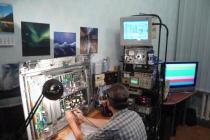The title of an excellent disinfector has long been strengthened behind quartz radiation. The procedure for its use is familiar to almost all of us. However, the scope of the device has gone beyond the borders of medical institutions - a quartz lamp for the home is very popular today. But here a special type of device is selected for each room - this review will help you understand which lamp should be purchased.
Quartz lamps for home use are externally an electric lamp that has a quartz glass bulb. Unlike its "serious" medical counterparts, such a device will be small in size, which allows it to be used both for disinfection of a separate room and the person himself. Therefore, most of these devices portable.
It's all about the principle of work - radiated by it ultraviolet. Its waves kill the DNA of pathogenic microbes, fungi, viruses and bacteria, disrupting their intracellular synthesis. However, there is also the other side of the coin - ozone, which in large quantities is already dangerous to humans. This circumstance indicates that it is necessary to use a quartz lamp very carefully.

Types of devices
The future owner should know that there are several types of such devices:
- ordinary quartz lamp;
- bactericidal character;
- ozone free device.
What is the simplest device? This device in the classic version simply releases ozone into the air, which disinfects it. Such safety measures should be observed - leave the room at the time of its action, and then ventilate it. The taboo is also imposed on viewing the lamp without specially designed glasses- they usually come with the device in the kit, otherwise such radiation will be dangerous to the eyes.

Quartz open type lamp
A quartz bactericidallamp It is made of special glass - uviol type. This helps to release less ozone into the environment, but also has a deadly effect on microorganisms of alien origin. In fact, this option is not even quartz, but the erroneous name has become firmly established in everyday life.

Germicidal lamps with amalgam coating
Finally, ozone-free analogue and is completely made of quartz, but at the same time treated with a special composition of glass. We are talking about titanium dioxide - it does not allow ozone to be released into the surrounding space in large quantities.

Home model quartz lamp - preferably the last two options. This choice is due to security issues. But a separate issue in this topic is also wall irradiators, which are analogous to the usual quartz apparatus.
The constructive device of a quartz lamp device divides it into two types - open and shielded models. The ban on being in the same room with the lamp during operation applies specifically to the first. And during exposure to shielded models, you can be present with them in the same room - such devices are already classified as household appliances.
The shielded model is a quartz lamp closed type. Another name is a recirculator (due to the fact that the rays are inside the case and do not go outside). The air that passes through the device is also cleaned there.

Closed type quartz lamp
Different models will have different power - some are able to drive up to one hundred cubic meters of air in an hour. At the same time, the bactericidal efficiency of the apparatus reaches 99%.
Just these lamps can work in continuous mode- they can be left on for up to 7 days.
Scope of application
Who needs such a device and why? The urgency of the acquisition especially increases in those families where there is a constantly ill child, an elderly person or one who suffers from chronic diseases. Use quartz lamps designed to disinfect the room, and at the height of the season of airborne infections.
In addition to fighting viruses, quartz irradiation can treat diseases:
- joints (including arthritis);
- respiratory organs (for example, the condition of bronchitis);
- sore throat;
- skin lesions (including wounds, ulcers and burns);
- other skin diseases.
However, before each use, consult a doctor(especially since each organism has an individual reaction to such radiation). And there are serious contraindications that make the use impossible:
- peptic ulcers of the stomach;
- blood diseases;
- kidney failure;
- oncological diseases;
- tuberculosis.
The presence of any of these problems makes the use of the device impossible. In any case, even in permitted cases, the use and dosage of such a device is strictly regulated by the doctor.

Treatment of psoriasis with a quartz lamp
Operating rules
During the process of quartzization with open devices, it is forbidden to be in the same room with him, not only to people - the instructions for use prescribe to take animals out and take out plants. There are other specific rules that should be followed. After turning on the device, you must leave the room, tightly closing the door behind you. Ensure that no one enters the treated room - violations are fraught negative impact on skin and eye tissues. In addition, due to constant exposure to UV rays, some interior items will fade over time.
Manufacturers offer the following instrument location:
- lamps on the ceiling;
- wall options;
- desktop;
- portable.
It doesn't matter where the device is located - the impact will be equally as effective as possible.
Some more information on how to use various types lamps.
- UV rays will only show their properties on open areas . This means that objects in the shade will not fall into the impact zone.
- It is also important to wipe the dust because the microbes will only die in the top layer - the rays will not be able to penetrate deep inside.
- A home quartz open lamp should not work constantly, but according to a certain schedule.
- The power of the device is selected depending on the size of the room.
- Recirculators, due to the fans working inside, can be a source of noise. Another disadvantage of such devices is that they are rarely produced in mobile versions.
- For the convenience of processing different rooms, you can purchase double action device- it will switch from open quartz to recirculation mode.
- Bactericidal quartz lamps of directional action are aimed at providing a therapeutic effect. Their low power does not harm health - this is evidenced by the indication for use even in infants. For example, the compact and mobile device "Solnyshko" allows you to carry out wellness procedures.

Self-made lamp
A do-it-yourself quartz lamp is a completely achievable result. The only requirement is to have an understanding of electrical circuits. For self-manufacturing devices as materials you will need a DRL lamp and a table lamp, and from tools - a choke and a hammer (can be replaced with pliers). Next, let's do this.

The quartz emitter is ready, but the ultraviolet from such a "homemade" is very dangerous. Therefore, it should be used for disinfection, after making sure that there are no living organisms left in the room. There are also certain safety requirements.
- The product is connected to an extension cord, the wire of which is pulled under a tightly closed door.
- The plug plugs into an outlet in the next room.
- The period of operation of the device should not exceed half an hour.
- You can enter the room only after an hour and open the window for ventilation.
- The room can only be used when the smell disappears.
A quartz lamp device will be a useful acquisition, without causing any harm when used correctly. All family members will benefit from his work in terms of health.
People need ultraviolet light in moderate dosage. This need can only be satisfied in summer, on sunny days. The rest of the time there is a risk of a deficiency of ultraviolet radiation. A quartz lamp for the home will help to fill or prevent it.
Types of UV lamps
There are several classifications of ultraviolet lamps according to different parameters. According to the principle of ozone formation, devices are divided into:
- Ozone - radiation interacts with oxygen, ozone is formed, in high concentrations it is harmful to the body. If an ozone lamp for quartz treatment is installed in the room, it is important to ventilate frequently.
- Ozone-free - the lamp bulb is made of quartz glass with a special coating. Ozone is not generated when interacting with air.
According to the mobility parameter, bactericidal lamps can be:
- portable - easily moved from room to room;
- stationary - disinfect more rooms, are used in medical institutions.
According to the principle of operation and purpose, UV devices are divided into:
- open - they scatter ultraviolet light throughout the room, are used in the absence of people and animals, these are quartz lamps for disinfecting the room;
- closed (recirculators) - they process a certain object, after turning on the device it is not required to leave the room;
- special applications (both medical and household) - used in the physiotherapy treatment of diseases, help fight colds, supplemented with nozzles, glasses, used to get a tan, this is the most common ultraviolet lamp for home use.
Depending on the method of fastening, there are quartzizers:
- floor;
- hinged;
- desktop.
What is a quartz lamp for?

A quartz UV lamp is a device based on quartz glass that only transmits ultraviolet rays. This radiation has bactericidal properties, provokes the production of vitamin D by the human body, strengthens the immune system in winter, compensating for the deficiency of sunlight. UV lamps for home use are used to disinfect the room, dry nails after applying a manicure, give the skin a tan color and cope with a number of diseases.
Irradiation is divided into general and local, with the use of nozzles (tubes) that focus the radiation into a given area. The instructions describe in detail what a particular nozzle is for, and how long you can be exposed to UV rays, and what radiation spectrum a particular device has for home use. Indications for the use of a curative UV lamp:
- colds, SARS, influenza, inflammation of the upper respiratory tract;
- skin diseases: eczema, psoriasis, etc.;
- joint diseases;
- prevention of rickets;
- difficult to heal wounds;
- ulcers, bedsores;
- gynecological indications;
- neuritis.
Quartzizer household bactericidal

An ultraviolet irradiator is needed to quartz the premises, destroying viruses and other infectious agents. A bactericidal lamp for the home is useful for families where there are often sick kids. With a device for home use, you can disinfect an apartment for half an hour a day, you need to turn it on for 15 minutes, then take a break for a quarter of an hour, and reactivate the device for the same time. In this mode, it works in a room up to 20 square meters.
For tanning at home
Not all UV lamps for home use are suitable for tanning. If you try to tan under an ultraviolet device that is not designed for this, there is a risk of getting burned, accelerating skin aging. In the instructions for quartz devices for special applications, there is often a note that the device performs the function of a mini-tanning bed. It is not necessary to buy a quartzizer only for tanning, many therapeutic UV devices have this property. There are special installations created for tanning enthusiasts, mini-tanning salons.
UV lamp for plants
An ordinary UV lamp for disinfection of premises is not suitable for highlighting seedlings or a home flower garden. When rooms are being treated with an open lamp, plants are recommended to be removed, because an excess of UV rays is harmful and even fatal for them. Manufacturers produce phytolamps based on LEDs for supplementary illumination of green spaces during a period of lack of natural light.
This does not mean that ultraviolet is absolutely contraindicated for plants, for example, UV rays with a wavelength of 315-380 nm stimulate the synthesis of vitamins, radiation with a wavelength of 280-315 nm makes plants more cold-resistant, so be sure to read the instructions for your UV device for adjusting the parameters of radiation power, wavelength. For pest control, it is useful to turn on an ultraviolet irradiator for home use for a few minutes (no more than 3-5).

How to choose a quartz lamp for home
To understand which UV lamp for home use is right for you, you need to figure out how it will be used. If you need a bactericidal lamp for the home to disinfect the room, and it is possible to eliminate all household members from it at this time, including animals and favorite plants, you can plan to purchase an open lamp. Such devices kill microorganisms on all surfaces that ultraviolet can reach, they are turned on to treat the room when there is a sick child or adult in the apartment (in the absence of people).
Devices that can work safely in a room with people are open type irradiators with a screen or recirculators. There are models whose purpose is the disinfection of surfaces and enclosed spaces: shelves in cabinets, refrigerators, and so on. When choosing the power of the equipment, it is important to know the volume of the room in which it will function. The choice between wall-mounted, mobile or portable models depends on whether you are going to move the unit.
Attention should also be paid to the technical data of the device, the availability of a guarantee, the brand of the manufacturer. Read reviews of popular devices before buying. If you buy a small device with nozzles for quartzing ENT organs, you should know that if you remove all these tubes, you can quartz a small area of \u200b\u200bthe apartment, no more than 3 square meters. This is enough to carry out local disinfection of the crib, bathroom, but not enough for the whole room.

How much does a bactericidal irradiator cost
Prices for homemade "germ exterminators" start at 1,200 rubles and reach 30,000 rubles (and sometimes even overcome it). These are only quartzizers, the cost of home solariums is not taken into account. It is easy to choose a worthy version of the device for home use at the right price, the assortment is rich, models from the Russian manufacturer producing Sun quartz installations are popular. The average price of a high-quality functional ultraviolet apparatus of this company is 2100-2900 rubles.
Another well-known manufacturer is Kristall. Simple open-type irradiators made under this brand cost 1800 rubles, a recirculator is sold for 4500-4700 rubles, there are models with a timer. Another Russian company producing bactericidal devices is Elektronika. The average cost of her UV irradiator is 3000 rubles. Devices of the more expensive Dezar class cost about 10,000 rubles.
Do-it-yourself ultraviolet lamp
Do-it-yourself hobbyists share their experience in making a mini quartzizer for home use, which is quite suitable for disinfecting a cellar or other utility room. You will need a DRL lamp. To process a pantry, a small room, a lamp of less than 125 watts is enough. In a large cellar, a more powerful one is needed. Place the lamp in a bag or wrap it in a rag, put on gloves, goggles, gently break the lamp bulb with a hammer without damaging its insides.
Caution is needed, as DRL contains mercury. The sealed tube left after the removal of the outer bulb is the quartz lamp. Then it needs to be connected to a choke, or an incandescent lamp connected in series to it. You can assemble a quartz lamp on the basis of any table lamp; the one with a clothespin that allows you to direct the radiation flux is convenient. The ultraviolet rays generated by a homemade device are dangerous for the skin and the retina of the eye, a prerequisite: use it only in the absence of people, animals, plants.
Video: apparatus Sun
Many people keep indoor plants in their apartments. At the same time, for some, this is not only a great way to revive and decorate the interior of the house, but also a good income option. Today, many people grow indoor flowers at home for sale.
To get a beautiful and healthier indoor plant that will not only please the eye, but also serve as an excellent replenishment of the family budget, it is necessary to create favorable growing conditions for the plant. And what is most important for plants, if not light. Flower growers often use ultraviolet lamps to grow indoor flowers.
This type of lighting device will provide any type of houseplant with the necessary light flux for its life. At the same time, such a lamp can either be purchased in a store or be made by hand. Our today's article will tell you about what you need to consider and know when making and using ultraviolet lamps for plants.
Phytolamp: what is it
An ultraviolet lamp designed for additional illumination of indoor plants is also called a phytolamp. This unusual lighting device is used to provide the light regime for certain types of indoor flowers.
Note! The greatest need for this type of lamp arises in the autumn-winter period.
Phytolamp option
If the optimal light regime is not created for the plant, then it will soon wither and die. The use of ultraviolet lamps will prevent such a sad outcome, and your indoor flora will develop in the right framework. In this situation, such a flower lamp will be perceived as a kind of artificial sun. The light from the lamp will be used by the plant for photosynthesis in the same way as from the real sun. As a result of such illumination, the flower will release oxygen and energy, which will go to the growth and development of the plant. In this way, your indoor flora will receive optimal conditions for growth and will please you with health, excellent appearance and beautiful flowering.
Note! It is advisable to use ultraviolet illumination only for those ornamental plants who need long daylight hours. Usually these are flowers whose homeland is the tropic and well-lit areas.
But it is not always possible to create suitable conditions for a home “mini-gardener” without the cost of electricity consumption. In order to minimize costs and increase the survival of plants at home, ultraviolet lamps were invented.
What kind of lighting is required for growing plants
When creating artificial lighting indoor plants with your own hands, you need to know what kind of lighting is actually required for flowers. Otherwise, you can create the wrong backlight, which will only hasten the death of your home front garden.

indoor plant lighting
The luminous flux that the phytolamp creates must meet the following requirements:
- be as close as possible to natural light, which gives the sun throughout the daylight hours;
- the duration of lighting should coincide by the hour with the requirements of one or another type of indoor flowers;
- the spectrum of electromagnetic radiation that the lighting device creates should be similar to the natural lighting conditions of a plant in the wild;
- at least the minimum satisfaction of the needs of the flower in the light;
- the level of ultraviolet radiation must meet the standards and not exceed it.
Note! To date, there are a wide variety of phytolamps that are capable of producing different luminous flux in terms of power and other characteristics. As a result, their influence will also be different. Such a lamp, bought or made with your own hands, can stimulate the development of shoots and fruits, speed up or slow down flowering, etc.

flower response to light
If the type of phytolamp was chosen incorrectly, then the plant itself will signal you about this with an uncharacteristic view:
- withered or drooping leaves;
- the appearance of sunburn on the leaves;
- fading of the leaf blade;
- lack of a flowering period or fruit formation;
- the appearance of pests. Most often, a brood of a spider mite can be found in a pot;
- the appearance of a disease on a plant, etc.
Today, artificial lighting, which implements such a lamp, has several usage patterns:
- stimulation of the intensity of photosynthesis. In this case, the lamp is used as an additional light source;
- occasional use case. It implies the inclusion of additional illumination if it is necessary to artificially increase the duration of daylight hours. This scheme is relevant for the autumn-winter period;
- scheme for the complete replacement of natural light. It makes it possible to fully regulate the process of development and growth of the entire home front garden.
Note! The scheme for the complete transfer of plants to artificial lighting can only be used in those rooms where it is possible to control the climate. In this case, maintaining a balance of growing conditions will allow you to get strong and healthy plants.
What you need to know when using phytolamps
To use artificial ultraviolet or any other type of DIY lighting, you must adhere to the following recommendations:
- the closer the lamp is placed to the plant object, the more pronounced will be its effect. But here you should be very careful not to create a situation of excessive heat generation by the lamp. This can lead to negative phenomena;
Note! When the light source is 20 cm away from the plants, the effectiveness of such illumination will be achieved using 70 cotton lamps on each square meter earth.

Placement of the UV Lamp
- when daylight hours are shortened during the cold season, the flower lighting time should be increased by four hours;
- the luminous flux that the lamp emits must be directed directly at the plant.
The use of additional artificial lighting has the following advantages:
- makes it possible to grow any flowers at home, even from tropical camps;
- allows you to create a small garden at home and grow plants even in winter;
- as an option to eliminate spider mites.
The last option should be considered in more detail. Dressed up growing conditions in pots can detect signs of spider mites. The spider mite is characterized by the appearance of cobwebs on the plant.

spider mite
The presence of a spider mite in a pot indicates that the plant is sick. The causes of the appearance of a spider mite can be as improper care, and infection of healthy indoor flora from an overgrown flower brought into the house. Due to the presence of spider mites, plants cannot develop normally and die soon. Therefore, when this mite is found on decorative flowers, you must immediately begin to fight it. Most often, an ultraviolet lamp has proven itself in the elimination of spider mites, which is either made by hand or simply bought.
UV effect of the lamp on living objects
It is known that there must be good reasons for using ultraviolet radiation. This is due to the fact that for the most part such radiation has Negative influence on the growth and development of plants, as well as other living objects (for example, spider mites).

Ultraviolet radiation
For plants, only the following colors of radiation are useful:
- red - promotes seed germination;
- blue - provokes cell division;
- purple - allowed in small quantities. Has a stimulating effect.
To illuminate plants, an ultraviolet lamp, bought or made by oneself, should not emit far ultraviolet light. Therefore, tanning lamps, as well as bactericidal lamps, are not suitable for these purposes. Because of this, it is very important to choose the right or make your own lamp for lighting indoor plants.
How to choose a phytolamp correctly

UV lamp option
Intending to use an ultraviolet phytolamp, it is important to choose the right device so that its negative effect on living objects is minimized. Here you need to be guided by the following selection parameters:
- slight ultraviolet radiation;
- rejection of lamps that give far ultraviolet radiation;
- purpose of the product. For what purposes is the lamp supposed to be used: accelerating the development of a plant or seeds, or simply maintaining at the level of daylight hours;
- at what distance should the device be placed from plantings or flower pots;
- the angle of radiation that this or that ultraviolet lamp gives;
- desired spectrum. It determines the purpose of the product;
- dimensions of the lighting device. The size of the lamp should cover the area to be illuminated. If necessary, you can use several lighting fixtures.
In addition, phytolamps with ultraviolet radiation should consume a minimum of electricity so as not to scare you with utility bills.
Also, when choosing a lighting device, one must also take into account the variety of plants for which they are intended to illuminate.
Independent production of phytolamps
Today, almost any lighting fixtures can be made with your own hands and not spend money on buying a fixture in a store.
With your own hands, a lamp with ultraviolet radiation for lighting plants can be made with little or no problems. In order to make such a phytolamp with your own hands, you will need basic knowledge in electrical engineering, some materials and the desire to make something on your own.
Note! A kit for self-assembly of the UV lamp can be purchased at the store.
To assemble such a lamp you will need:
- metal or wooden base;
- power unit;
- ultraviolet light source with the necessary characteristics;
- wires;
- drivers;
- connector;
- fastener or solder.
Some of the above parts can be taken from old lamps.
The manufacture of the device is as follows:
- on the selected basis, you need to place an ultraviolet source;
- then wires are connected to it;
Note! Observe polarity when connecting wires.
- you also need to connect the connector, driver and power supply to the circuit. For assembly, you can use the following scheme;

Assembly diagram of an ultraviolet lamp for flowers
- when all the elements of the lamp are connected, it is necessary to fix them on the base. You can close such products with a glass case or do without it at all;
- after that, you need to check the correct connection of all elements by connecting the lamp to the power supply.
After that, you just have to correctly position the do-it-yourself ultraviolet lamp near the plants.
Conclusion
To make an ultraviolet phytolamp with your own hands, you need to take into account many nuances and recommendations. Otherwise, such a lamp can lead to the death of the illuminated plants. At the same time, it is not enough to make such a lighting device, it still needs to be placed correctly so that all the efforts expended are not in vain.
The benefits of ultraviolet emitters have been proven in medical practice and not only. Now such disinfectants are becoming more common for use in domestic conditions. In an apartment, office, they are used for the purpose of prevention. You can buy it or create it yourself. How to do it yourself is a question that worries many.
Peculiarities
Ultraviolet is a segment of the electromagnetic spectrum of high energy power. The emission spectrum differs depending on the wavelength:
- UVC wavelength is 180-290 nm, this radiation is dangerous for living beings.
- UVB - medium wavelength range - 290-320 nm. It is vital for the existence of reptiles.
- UVA - long waves - 320-400 nm.
UV lamps differ depending on the length of the spectrum, power, shape and other parameters. Due to this, their application is extensive.
Important! Such lamps are durable, on average, the service life is 1 year. In some cases, replacement is needed more often.
Classification
The first classification that is important to users is the type of lamps that can be used for the home. They are ozone and non-ozone. In the first case, UV radiation promotes the formation of ozone from oxygen. Such lamps can be used only if there are no people and other living beings, plants in the room, since ozone is destructive not only for bacteria, but also for all living things. After turning off the device with a light bulb of this type, ventilate the room.
UV irradiatorThe second option - ozone-free, due to a special coating on the flask, do not emit a destructive element into the air, but at the same time they destroy microbes. It is these that are most often used in domestic conditions.
According to the mobility parameter, there are portable and stationary lamps.
By type of operation:
- Open. It is open devices that are convenient for use in medical institutions. Such lamps are not protected by a screen, and all radiation affects pathogens indoors. They can also be used at home, but it is necessary that no one is in the room that is being processed.
- Closed. They are also called recirculators. This type is often used to locally affect or process a particular object. It is not necessary to leave the room when the lamp in the protective case is on.
For domestic use in medicinal purposes there are special devices - UV lamps for special purposes. They are equipped with nozzles of different sizes and goggles.
 UV lamp "Sunshine" for domestic use
UV lamp "Sunshine" for domestic use Scope of application
The use of UV lamps that give different wavelengths is huge. From cosmetology to treatment.
The medicine
In medicine, the use of UV lamps has been practiced for a long time. The main task that is placed in front of the device is to quickly disinfect the entire room, the surfaces of walls, floors, objects that are in it. Devices that are used in medical institutions are capable of:
 UV treatment
UV treatment For plants
In winter, it is possible to provide plants in greenhouses and greenhouses with UV rays only using special lamps. For plants, UV lamps with different wavelengths are used, it depends on its physiological characteristics and the further cycle.
So, long-wave radiation stimulates growth and development, medium - give resistance to temperature drops. Short waves for plants are detrimental and are not used.
Cosmetology
Increasingly, UV lamps are used in cosmetology, the simplest example is the sources of ultraviolet radiation in solariums. Long waves are used to create an even tan.
Today, compact devices with UV radiation are popular for building nails and creating a neat manicure. Their main task is to dry the gel, shellac, which is applied to the nails. Another possibility is to protect the nail plates from fungus.
 Lamp for polymerization of gel and shellac
Lamp for polymerization of gel and shellac Other areas
In addition, they apply:
- Checking banknotes. A special mark is applied to banknotes, which is visible only in UV rays. Similar devices are in banks, many stores.
- Disinfection of drinking water. Together with chlorination, ozonation or disinfection with UV rays is used.
- in chemical analysis.
- For catching insects. This effect is achieved due to the shifted visible range in most insects.
- For restoration. Such a device helps to see the old layers of varnish and new ones, they look different in a similar glow. For other light sources, such changes are invisible, as well as for the human eye.
- For biotechnology in order to obtain a genetic mutation.
- They are used in terrariums where they contain reptiles and turtles, in aquariums.
- For the formation of lighting effects at various events.
What can replace UV lamps?
You can replace the UV lamp, but what exactly depends on the tasks that it performed. So, in the case of plants, you can create a wave of fluora-type lighting from blue and red LEDs by connecting them in a certain sequence.
 LED Alternative
LED Alternative Another type of alternative lamp is an amalgam lamp used for disinfection. They have become widespread relatively recently. Inside it is a hard coating of an alloy of indium, bismuth and mercury. When heating occurs, mercury vapor is released and begins to emit ultraviolet light.
A huge plus is that ozone is not formed, while microbes are destroyed just as intensively. If the amalgam lamp is damaged during operation, then mercury vapor will be released, but not in the same concentration as when a conventional ultraviolet lamp is damaged. As for cracks or holes in a non-working lamp, mercury is bound by other metals and does not pose a danger to humans.
Often looking for an alternative to UV lamps to dry the gel on the nails, but at the moment there is no equivalent replacement.
Device
The principle of operation of a UV lamp is very similar to the essence of the operation of a fluorescent device. In fact, these are the same light sources, inside their mercury vapor. The only difference is what the flask is made of or how it is coated from the inside. Depending on this or that coating, the wavelength, the color of the glow changes. For standard UV lamps, there is no phosphor coating, so a person does not see the radiation.
Important! It is dangerous to stay in the room while it is being treated with such a lamp, and even more so to look at it.
How to do at home?
You can create a UV lamp with your own hands, and it's not so difficult. In the process you will need:
- Ordinary arc mercury light bulb (DRL). Its power is not less than 125 watts. These are used in street lamps.
- Throttle for ignition.
- The cartridge where it will be screwed.
- Wooden stand to hold the lamp.
- Hammer or vise.
- A piece of fabric to wrap around the bulb.
 Components for a homemade UV lamp
Components for a homemade UV lamp The process of creating a homemade irradiator is extremely simple:
- Take a workable arc mercury lamp of suitable power.
- Wrap her flask with cloth and lightly hit it with a hammer. If there is a vise, then the lamp can be wrapped in cloth and clamped in them and gently twist the handle and squeeze it. In this case, the risk of damage inner part less.
- Upon impact, you need to break the flask, but do not damage the glass tube and the electrodes that are inside. It is advisable to do this on the street so as not to collect fragments around the house.
- Leave fragments in matter.
- Now you need to prepare the base for the lamp. Mount the throttle on a wooden platform, connect the socket for screwing in the lamp.
- Pieces of glass from the light bulb may remain on the base, they must be carefully removed with pliers or other suitable tool.
- The next step is to wipe internal elements cotton soaked in alcohol. The main task is to remove the white coating that is there.
- The inner glass element with electrodes remained on the base, it remains only to screw it into the cartridge and use it for its intended purpose.

Expert opinion
Alexey Bartosh
Specialist in the repair, maintenance of electrical equipment and industrial electronics.
Ask an expertSuch an ultraviolet lamp is open, so its operation must be carried out in accordance with the rules for such irradiators.
Rules:
- The room should not be people, animals, it is desirable to remove all plants.
- Processing of rooms should be carried out systematically.
- After working with a UV lamp, ventilate the room well, if this is done poorly, a person may be poisoned while in it.
- Do not look at the lamp, otherwise you can get a retinal burn.
- Self-treatment with such powerful lamps is prohibited, they can irradiate rooms in the house, but without the presence of people.
 homemade lamp
homemade lamp Simple UV lamps for phone and flashlight
A very simple and primitive UV light bulb can be made from improvised means. It will not give any bacterial effects, as well as harm to humans. But she will be able to check banknotes or read a message on a sheet written with a fluorescent marker.
This device, despite its seemingly purely medical "registration", can be used in everyday life. Take at least quartzization of residential premises in the season of exacerbation of SARS; one of my friends with the help of this apparatus defeated the fungus in the cellar of his house.
Powerful factory edge irradiators are equipped with DRT type lamps. It was the inaccessibility of the latter that prompted me to look for analogues. Very soon came to hand ... well-known DRL lamps:
According to the passport: "... the light source in the DRL lamps is a quartz burner placed in a glass flask coated with a phosphor and filled with an inert gas."
The preparation of the DRL for work in a new capacity is as follows: at the junction of the base and the bulb of the lamp, we make an annular incision on the glass with a glass cutter or a piece of hard alloy:
Further, placing the bulb of the lamp in a rag, putting on glasses and mittens on your hands, carefully tap on the balloon with a light object, for example, pliers, achieving damage to it (the insides must remain intact!); as a result we get:
Carefully remove the remnants of glass near the base - the lamp is ready for use. Carefully, preferably with round-nose pliers, we screw the burner into the E40 cartridge:
and assemble the electrical circuit for turning on the lamp:
The throttle is selected based on the power of the DRL. By the way, in the whole structure it is the most expensive part. If the lamps cost about 200-250 rubles, then the chokes - 850-1000. I came across information that a battery of paper capacitors can be used as a current limiter for the DRL-250 total capacity 40 microfarads for a voltage of at least 250 volts. I do not recommend using air heating elements or nichrome spirals as ballast - this significantly complicates the device as a whole and makes it less safe.
In my version, this is the design:
As you can see, the cartridge is installed on the throttle cover, and I attached an impromptu reflector from a piece of galvanized steel with rivets along the perimeter.
In this form, the lamp has been working for me for almost a year, as they say, without any complaints and breakdowns.




















